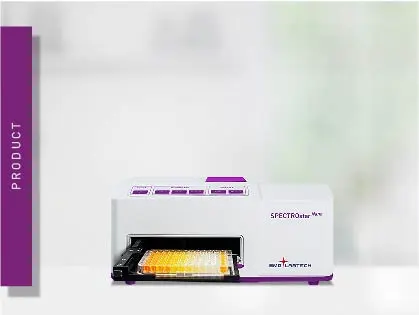
SPECTROstar Nano
Absorbance plate reader with cuvette port
For absorbance measurements, the optical density (O.D.) is a logarithmic measurement of the percent transmission (%T) and it can be represented by the equation, A = log10 100 / %T.
 Dr EJ Dell
Dr EJ Dell
That means a sample with:
In other words, if a sample has an O.D. greater than 3, this means that only 1 photon of light out of 1,000 will be measured by the detector. Even with the most sophisticated instruments, this small amount of light is very hard to accurately detect above the background noise. Therefore, measurements above 3 O.D. will have greater error and will in turn be less accurate than measurements taken at a lower O.D. Thus it is always recommended to dilute samples that are >3.0 O.D. and then to factor in the dilution factor to the final measurement. This is also shown in the following graph, note how the measurement is no longer linear at high concentrations, which correspond to higher O.D. values.
Absorbance plate reader with cuvette port
Powerful and most sensitive HTS plate reader
Most flexible Plate Reader for Assay Development
Upgradeable single and multi-mode microplate reader series
Flexible microplate reader with simplified workflows
ELISAs are a popular tool to detect or measure biological molecules in the life sciences. Find out how microplate readers can be used to advance research using immunoassays.
LanthaScreen is a TR-FRET technology which can be used to measure kinase activity, compound binding, and post-translation modification events. Read more about this type of assay here.
Although the concept of fluorescence gain has always been hard to grasp, it is a make-or-break parameter in microplate reading. Read here how to adjust it optimally.
HTRF combines time-resolved fluorescence detection with FRET and is mainly used for drug screening in high-throughput. Read more about this measurement approach here.
This article clarifies what integration time is, why it is important and how you can optimise the integration time for TR-FRET measurements.
Dual-reporter assays with stable, long-lived luminescence reporters that emit at different wavelengths offer several advantages for higher-throughput detection. Read more here.